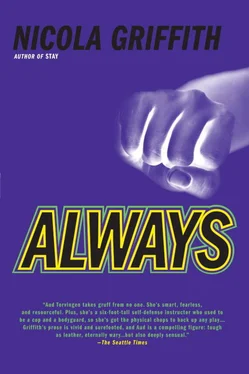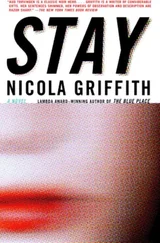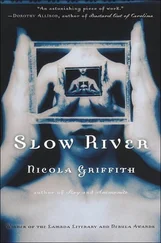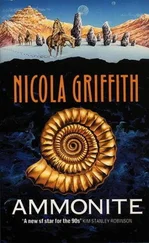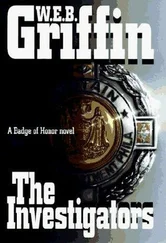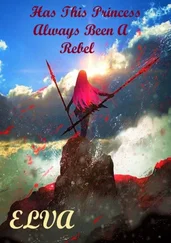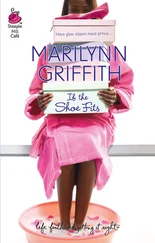“Are you really trying?” I said, and she said she was. Later that day, I found Frank King, my first APD partner, six-feet-three and two hundred thirty pounds, and put my arm on his shoulder and said, “Bend it,” and he couldn’t.
I didn’t believe in ki, or the energy from the earth, or light shooting out of my fingertips, but the fact was, when I relaxed and thought about energy flowing smooth and liquid through my arms, my arm didn’t bend.
I wrestled with the idea for a week, and I told Bonnie the idea of ki was nonsense, and she shrugged and said, “What does it matter?” and after a while, it didn’t. I could feel when I got into the zone and became fluid and unbendable. And then one night Frank and I were called to a fire. The firefighters were already there, herding people back, unspooling their hose, locking down the connection, but just as the water began to stiffen and bulge through the flattened canvas, a chunk of burning roof pinwheeled in orange flame onto the lead hose man, and he’d gone down. The hose whipped and snapped like a dying moray eel and snaked itself ten yards across the pavement, leaping and spraying the crowd before I got to the hydrant and cut the water supply. When another firefighter took the nozzle and shouted, “I’m good!” I opened the hydrant again, and watched the hose turn into a live thing, and something I couldn’t articulate clicked in my brain.
In one of those strange coincidences, when I got home, too wired to sleep, I turned on the Discovery Channel and saw a program about crocodiles. “This twenty-two-foot croc can run more than twenty miles an hour,” the narrator said in an Australian accent, “but when you take a look at its spinal structure, that doesn’t seem possible. Researchers at the University of Melbourne tell us that the key to this incredible strength and flexibility is hydraulics.” And they showed two geeky-looking academics draping an empty hose over two saw horses fifteen feet apart, turning on the water, and watching the hose transform from a limp tube to an arcing, stiff sausage. They hung weights from it; it didn’t bend.
Hydraulics. It wasn’t the bone and ligaments and tendons that made an arm strong, it was the blood pumping through the vascular system, the plasma in the cells of sclera and muscle.
New Boy didn’t yet know this. Directing him, from my position as an uke, was a little like trying to direct a high-pressure hose from the hydrant end instead of the nozzle.
Then it was my turn as nage. It would have been very easy to breathe in two long gushes and take him down in a perfect moving spiral, pin him helpless to the mat, nod unemotionally when he slapped, let him up, do it all again. But he wouldn’t learn anything, and neither would I. And so the first time, I took control very gently, like sliding my palm under a tap runoff and tilting it so it was almost, but not quite, perpendicular and the water landed an inch to the right of the drain. For a moment, he tried to fight. He tried to draw his wrist up, but my palm on his elbow was firm and I guided him kindly to the mat.
He slapped, and leapt up, rubbing his shoulder, and then looked confused when it didn’t hurt. But the sensei had seen it, and came over.
“Everything okay here? Jim?”
Jim looked at me, then nodded slowly.
“Continue,” the sensei said, and watched while I assumed hanmi, and Jim came at me, and I took him down, just as before. The sensei nodded, and gestured for us to swap roles, and I attacked Jim. I used my body to guide his hands and he took me down with the same puzzled look as before.
The sensei motioned Jim away, said, “Watch,” assumed hanmi, and nodded for me to attack.
We barely touched each other, but we felt each other’s strength clearly, and it was the difference between the exuberant rushing together of two mountain streams and the vast movement of ocean currents—the Kuroshio gliding past the North Atlantic Drift, separated by the continent of North America. I went down, and slapped, and stood.
He bowed with a thoughtful look.
When we sat again for the next demonstration, it wasn’t in rank order. I sat between Petra and an older man with red cheeks and grizzled hair, and the sensei held his wrists out behind him for a man with a tense face and long, black hair to take in ushiro tekubitori. The student flinched, even as he grabbed the wrists, and the sensei stepped backwards into tenchi nage. The student was already up on the balls of his feet, longing to go down so that he wouldn’t have to anticipate it anymore. Sensei threw him; the student rolled out well enough for me to guess he was perhaps yonkyu rank and to wonder why he would keep studying if he were so afraid.
We stood. Petra hesitated just a fraction before turning away and bowing to the student on her left, which left me with Mike.
Mike knew what he was doing. When he took my wrists, his arms were relaxed. It was clear he was ready to deal with a complete beginner or a master. I swept my right hand up and left down, stepped back smoothly with my left foot, then scissored my arms and sent him flying into a forward roll. He rolled like a big cat and came up grinning. I grinned back.
This time when we knelt, sensei beckoned me onto the mat to be his uke, and held out his left wrist. I grasped it in my right, careful to grip with my little finger, which so many people forget. We didn’t look into each other’s eyes, not yet, because this was for the class, not between us, but he paid me the courtesy of not holding back when he whipped me into kotegaeshi, and I had to twist in midair and break-fall to save my wrist and ribs, and when he flipped me onto my stomach, he moved fast and not gently and he not only put me in a wrist pin but locked out my elbow and braced my upper arm against his thigh to torque my shoulder at an uncomfortable angle. I slapped. When I stood, the row of kneeling students were sitting very straight, eyes wide, except Mike, who was grinning even harder.
This time when we paired, Petra didn’t hesitate.
She was light and whippy but I took particular care to guide her neatly. “Wow,” she said, when she came up. Her eyes were wide-set and hazel, under straight brows. “Your energy is, like, really clear.”
I smiled and held out my other wrist, and she took it. It was like playing with a lariat: twist this way, twist that way, and everything is neatly coiled on the floor and perfectly still, with no more ability to get up and move without permission than a piece of old rope.
She held her left wrist out, and I took it with my right, and she frowned in concentration, turned her left hand over and out, stepped back with her left foot, pulled her elbow close to her body, put her right hand over mine and turned. I went down, but in real life I would simply have moved behind her on the diagonal, put my hand up, and kept turning until she was unbalanced and I could flip her over my hip. Or I could have twisted faster in midair and turned out of the wrist lock. But I went down, and waited patiently until she decided which way to step over me to flip me onto my stomach. A bit more fiddling and she had me in a decent shoulder pin.
I got up and took her wrist again, but this time before she moved, I said, “Spread your fingers. Just imagine it for a moment, then do it.” She frowned again. “Relax your shoulders. Imagine you can do this perfectly, and then do it.”
She did. She beamed. Held her left wrist out eagerly.
“This time, with your right hand, guide mine, turn it as though you’re rolling a fat sausage over in the air.” She did, and it gave a tighter, faster torque to the wrist lock. This time I wouldn’t have been able to do anything but go down.
Читать дальше
